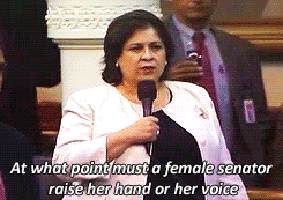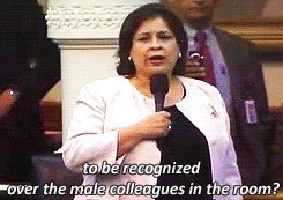Texas’ HB 2’s Journey From the Capitol to SCOTUS: GIF-splained
Since Gov. Rick Perry first signed Texas' omnibus anti-abortion bill into law, HB 2 has bounced from court to court, with some granting reprieves from the legislation and some allowing its enforcement. Confused? Never fear, a GIF-splanation is here!

Late on Tuesday evening, the Supreme Court blocked the strictest parts of Texas’ omnibus anti-abortion law, HB 2, allowing abortion facilities that don’t operate as ambulatory surgical centers to continue providing care. That ruling—a 6-3 decision with Justices Antonin Scalia, Clarence Thomas, and Samuel Alito dissenting—means that instead of just eight legal abortion facilities left in the state, up to 13 more abortion clinics could technically reopen to begin providing abortion services again. Many, however, have already sold their properties, laid off staff, and relinquished costly-to-maintain licenses.
Importantly, though, Tuesday’s SCOTUS ruling also allowed clinics in McAllen and El Paso to bypass the part of HB 2 that requires doctors who provide abortions to have admitting privileges at local hospitals, meaning that Texans who live in the Rio Grande Valley and rural West Texas could seek abortion care close to home instead of driving hundreds of miles to the nearest major metropolitan area, like San Antonio or Fort Worth.
It was a victory, though perhaps a temporary one. The Fifth Circuit Court of Appeals still has yet to hear the most recent federal challenge to HB 2 in its entirety, and reproductive rights supporters and abortion providers in Texas have grown accustomed to uncertainty as the new status quo.
Since Gov. Rick Perry signed HB 2 into law in September 2013, the law has bounced from court to court, with some granting reprieves from the law and others allowing its enforcement. Here, in GIF form, is a rundown of just where HB 2 has traveled over the past year. If it starts to get a little confusing, don’t worry:
It all began in the summer of 2013, when anti-choice Texas legislators filed the first version of the omnibus anti-abortion bill that would morph into HB 2. Hundreds of orange-clad Texans—according to Republican Lt. Gov. David Dewhurst, an “unruly mob”—descended on the state capitol in protest to support state Sen. Wendy Davis (D) in her 13-hour filibuster.
As the clock ticked down to midnight, state Sen. Leticia Van de Putte (D) posed the question that would send Texans in the capitol senate gallery into an uproar.
But anti-choice lawmakers came back to the capitol for another special legislative session the following week. Despite opposition from mainstream medical organizations and continued protests from thousands of Texans, those legislators then passed the anti-abortion restrictions.
The law has four main prongs: It restricts the prescription of medication abortions, bans abortion after 20 weeks, mandates that doctors who provide abortions have hospital admitting privileges by November 2013, and requires abortion facilities to operate as ambulatory surgical centers by September 2014.
In short, it’s a mess of a law that, when ultimately implemented, would shutter all but eight of Texas’ legal abortion providers.
But abortion providers in Texas refused to be cowed by the anti-choice legislature. In October 2013, they filed their first challenge to the law in federal district court in Austin.
That lawsuit challenged two parts of HB 2: the restrictions on medication abortions (which would require patients to make four separate trips to their doctors to take the abortion pill), and the requirement that doctors who provide abortions have hospital admitting privileges. Western District Judge Lee Yeakel was persuaded by the abortion providers’ arguments, and ruled that the law was unconstitutional just days before that part of it was set to go into effect on November 1.
But on Halloween night, a panel of judges on the Fifth Circuit Court of Appeals, to which the State of Texas had immediately appealed following Yeakel’s ruling, reversed the district court’s decision and ruled that the law could be enforced until the Fifth Circuit could hear the full case later on.
Abortion providers across Texas were forced to cancel dozens of appointments, and about one-fourth of Texas’ legal clinics had to close or stop providing abortion services.
Meanwhile, the Texas Department of State Health Services received a record 19,000 comments asking it to mitigate the damage done by HB 2’s ambulatory surgical center requirement—which would not go into effect for another year—and to do all it could to help abortion facilities remain open.
It didn’t work. DSHS codified the most conservative reading of HB 2 into its regulations in January 2014. That’s also when the Fifth Circuit Court of Appeals heard arguments from Texas abortion providers and the Texas attorney general’s office, whose job it is to defend the law, in court in New Orleans.
It didn’t go well for Texas abortion providers. In March, the Fifth Circuit ruled that the medication abortion and admitting privileges provisions of HB 2 were totally constitutional.
But just days after that Fifth Circuit ruling, Texas abortion providers returned to the federal district court in Austin, this time with a new lawsuit challenging different parts of HB 2—most significantly, the ambulatory surgical center requirement—and bringing a new legal angle to the admitting privileges requirement. This time, they asked the court to declare HB 2’s admitting privileges requirement unconstitutional specifically as it applied to clinics in El Paso and the Rio Grande Valley, where anti-choice hospital boards had refused to grant privileges to abortion providers.
Also in April, two Texas abortion providers—in El Paso and in Dallas—had their admitting privileges rescinded without warning.
The El Paso clinic in question never recovered, but in Dallas, the abortion providers were ultimately able to settle out of court and regain their privileges—after a local hospital had told them that, by providing abortion care, they damaged its “reputation.”
As the one-year anniversary of the passage of HB 2 approached in the summer of 2014, Texans continued to fight for access to legal abortion care, starting new abortion funds and shoring up existing ones. Others formed doula and support collectives to help Texans access not only abortion care, but prenatal care and other social support services. The Texas Policy Evaluation Project and the National Latina Institute for Reproductive Health continued to do vital work evaluating the impact of family planning cuts and the anti-abortion law.
As summer wound to a close, and the September 2014 deadline for HB 2’s ASC requirement approached, some Planned Parenthood providers announced plans to open ambulatory surgical centers. But the damage was clear: About half of Texas abortion providers had closed since lawmakers passed HB 2 in 2013.
In August, abortion providers brought their second challenge to HB 2 back to the district court in Austin, and once again Judge Lee Yeakel took on the case. His previous ruling on the first lawsuit gave providers reason to be cautiously optimistic that he might, this time, block HB 2’s ambulatory surgical center requirements, and give the McAllen and El Paso clinics reprieves from the admitting privileges rules.
A few weeks after the trial, Yeakel issued a sweeping ruling that barred the ASC provisions from going into effect across the state.
Only to have the state of Texas immediately appeal his ruling to the Fifth Circuit, which surprised everyone by not immediately overturning Yeakel’s injunction against HB 2.
Texas abortion providers and assistant attorneys general then appeared, once again, in court in New Orleans in front of a Fifth Circuit panel. They faced some tough-ass lines of questioning, and all signs pointed to the court putting HB 2 into full effect.
The signs were, sadly, correct. The Fifth Circuit ruled that the state of Texas could begin enforcing HB 2 in its entirety, even though it had not yet heard arguments on the merits of the case, only on whether the law should be able to go into effect while the merit trial was pending.
Overnight on October 3, all but eight of Texas’ legal abortion providers closed their doors.
But Texas abortion providers soldiered on, asking the Supreme Court to block the Fifth Circuit’s ruling, and thus to block HB 2, until the Fifth Circuit could fully hear the case. In the meantime, with the original challenge to HB 2 still pending in the Fifth Circuit—Texas abortion providers had asked the full court, rather than a three-judge panel, to take another look at the law—the Fifth Circuit denied abortion providers’ request to re-hear the case.
Then, on Tuesday evening, reproductive right supporters got a wonderful surprise: SCOTUS blocked the implementation of HB 2 until the Fifth Circuit could hear the case on its merits.
For now, Texas abortion clinics do not have to operate as ambulatory surgical centers, and as long as clinic doctors have admitting privileges, they can legally reopen to provide abortion care. In south and west Texas, doctors may provide abortion care without privileges.
The fight is hardly over: the second challenge to HB 2 is still pending before the Fifth Circuit, a court that is demonstrably hostile to abortion rights. And even with the SCOTUS ruling on Tuesday, Texas will still only have a fraction of the more than 40 abortion providers it had before HB 2.
But Texans fight on.



























